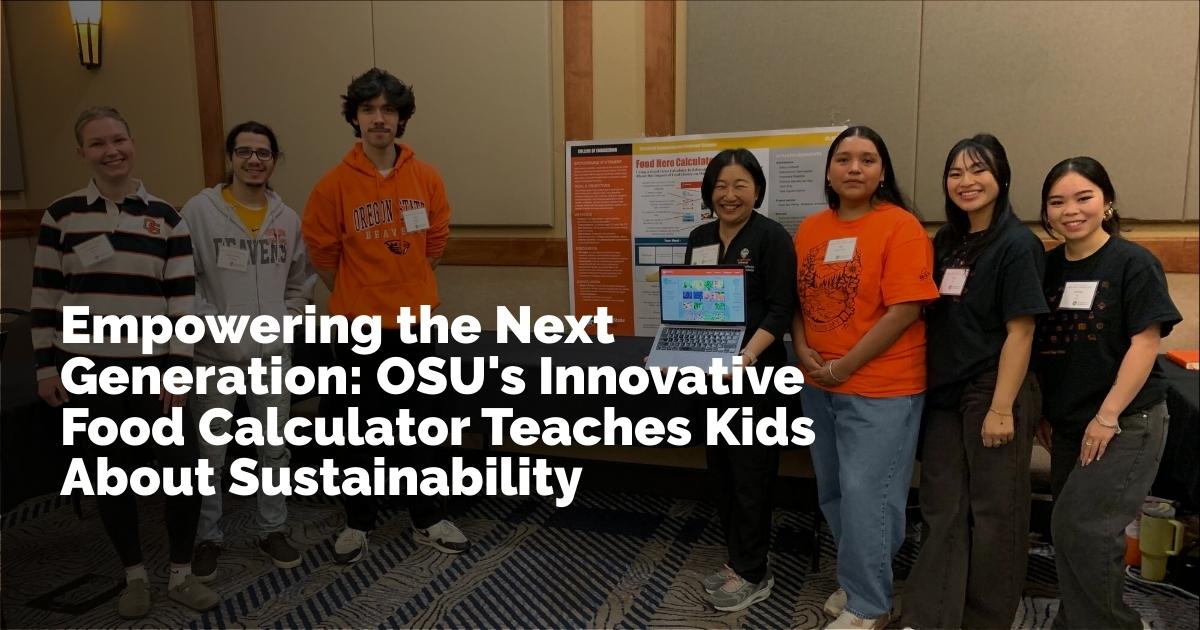Developing an Innovative and Accessible Tool for Kids
Combating Environmental Impact through Nutrition Education
Understanding our impact on the environment is crucial, especially regarding what we eat. Researchers, including Wong and her team, have identified a gap in existing nutritional resources—they largely emphasize calories and nutritional content but neglect the environmental consequences of food consumption. To address this, the team developed the Food Calculator, a novel tool that provides a tandem view of nutrition and environmental effects.
The unique aspect of the Food Calculator is its ability to help kids calculate the carbon and water footprints of their preferred meals. Carbon and water footprints are metrics that indicate the volume of greenhouse gases and the water resources expended in bringing a particular food item from the farm to the table. Foods with elevated carbon and water footprints inflict more significant damage on the planet, as explained by Wong.
The tool also comprises an engaging game that encourages kids to test and enhance their knowledge—melding learning with playful competition. By transforming complex environmental concepts into an engaging, interactive experience, Wong hopes to nurture ecological awareness from an early age.
Creating a Kid-Friendly Objective
The meticulous design of the Food Calculator prioritizes user-friendliness, especially for younger audiences. The team focused intensely on the aesthetic elements, including color schemes and the layout of results pages, to make them accessible. Special attention was paid to inclusivity, ensuring the tool accommodates children with different needs, such as color blindness.
As Underhill noted, thoughtful features like shadow effects on buttons and hover labels were incorporated to facilitate navigation. These seemingly minor adjustments are primary steps toward ensuring that every child can access and use the tool effectively.
In March, the prototype of the Food Calculator was tested by approximately 18 children aged 7 to 9 years old, who participated through OSU’s KidSpirit program. The exercise revealed crucial insights; notably, children often skip or disregard large text blocks. Introducing a gaming element was a game-changer in this regard—prompting kids to become notably fixated on the challenge. Hence, by simplifying language and adding playful visuals, alongside a consistently supportive tone, the tool naturally became more engaging for its young users.
The overarching aim is to raise consciousness about food choices without attaching guilt or enforcing restrictions. As Aguilar Carrion emphasized, the objective is to make kids more aware rather than experiencing punitive feelings over their eating habits.
Translating Classroom Knowledge into Community Impact
The Food Calculator’s developmental journey reflects the ambition and fervor of its creators to bridge classroom learning with tangible community impact. For Underhill and Aguilar Carrion, the project was not merely a requirement but an embodiment of their shared commitment to sustainability and meaningful work.
Aguilar Carrion, as a first-generation college student, articulated the importance of ensuring her work positively impacts people's lives instead of being just a string of code. The project inspired motivation through its mission-oriented goal, offering profound purpose throughout its implementation.
Wong, who mentors students through academic and extension programs, aims to instill this sense of purpose across the board. Her mentorship fosters opportunities where students can see the direct impact of their work within the community. The project itself is part of a larger nutrition education initiative supported by the National Institute of Environmental Health Sciences. Wong envisions integrating the tool within OSU Extension programs, tapping into the broader narrative of educating about healthy habits through storytelling and interactive engagement.
While the prototype testing provided invaluable feedback, the journey of this tool is far from over. Future improvements are envisioned to expand the database of foods beyond its current 25 offerings, embracing a range of culturally diverse options. Key definitions for terms like "carbon footprint" and "water footprint" will be further clarified through a glossary meant to enhance understanding. Lesson plans are also in the pipeline to aid educators in incorporating the tool effectively into their teachings.
Sustained Collaboration through OSU Extension
The continued growth and collaboration of the tool development are intertwined with OSU Extension’s cross-departmental support. Wong emphasizes the collective willingness within the Extension and Engagement Division to facilitate sharing resources and support throughout this initiative, highlighting a cornerstone of OSU's community-oriented ethos. Wong anticipates further growth in such collaborations, lauding the inclusion of non-Extension students—like the Computer Science capstone teams—in practical community engagement.
As the torch passes to future capstone teams, Wong expressed her hopes for the graduates—it is her wish that they cultivate a heart centered on-service and remain committed as scholars invested in the intersection of human and environmental health.
Celebrating Achievements and Looking Toward the Future
The culmination of their hard work showcased itself at the OSU Extension Family and Community Health annual conference in May, with Wong, Aguilar Carrion, and their team proudly presenting their work during a poster session in Bend, Oregon.
While the Food Calculator is a significant stride toward engaging kids with their dietary choices on an ecological level, the initiative is securely anchored in broader educational and community goals, reflecting a meaningful convergence of classroom learning and actionable community impact.
Projects like the Food Calculator demonstrate how academic pursuits can be engineered thoughtfully to inform, educate, and inspire future generations to think critically about the environmental ramifications of everyday choices, fostering a more aware and responsible populace.
출처 : Original Source

